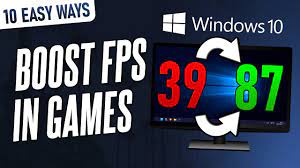In the realm of gaming, frames per second (FPS) reigns supreme. It’s the measure of how many images your computer can display each second, and it directly impacts the smoothness and fluidity of your gaming experience. A high FPS ensures a responsive, stutter-free experience, while a low FPS can lead to choppy visuals and lag, hampering your gameplay and enjoyment.
Understanding FPS and Its Significance
Imagine a flipbook. Each page represents a single frame, and when you flip through the pages rapidly, you create the illusion of motion. Similarly, in video games, FPS determines how many frames are displayed per second. The higher the FPS, the smoother the animation appears.
A low FPS can manifest in various ways, including:
Stuttering or choppy visuals: The game appears to lag or jerk, making it difficult to follow the action.
Input lag: There’s a noticeable delay between your actions and the game’s response.
Screen tearing: The image appears to be torn or split, creating an unpleasant visual artifact.
Boosting FPS: The Gamer’s Toolkit
Fortunately, there are several strategies you can employ to enhance your FPS and elevate your gaming experience:
Harness the Power of Game Settings
Dive into the game’s settings menu and explore the graphics options. Many games offer various settings that can significantly impact FPS. Consider reducing graphical details like shadows, anti-aliasing, and texture quality. These adjustments can free up processing power, leading to smoother gameplay.
Enable Game Mode (Windows 10 and 11)
Windows 10 and 11 feature a built-in Game Mode that prioritizes gaming performance by allocating more system resources to your active game. To enable Game Mode, open the Settings app, navigate to Gaming, and toggle Game Mode on.
Keep Your Graphics Card Drivers Updated
Outdated graphics drivers can hinder your gaming performance. Ensure you have the latest drivers installed for your graphics card. This can be done through the manufacturer’s website or using dedicated driver update utilities.
Optimize Background Processes
Background processes can consume system resources, potentially affecting your FPS. Consider disabling unnecessary startup programs and temporarily closing background applications while gaming to maximize performance.
Reduce Resolution for a Performance Boost
Resolution, the number of pixels displayed on the screen, plays a crucial role in FPS. Lowering the resolution can significantly boost FPS, especially on less powerful systems.
Hardware Upgrades for Enhanced Performance
If your system is struggling to maintain a stable FPS, consider upgrading hardware components such as the graphics card, CPU, or RAM. These upgrades can provide a substantial performance boost, especially for demanding games.
Utilize FPS Testers for Performance Monitoring
FPS tester is invaluable tools for monitoring your game’s performance. They provide real-time FPS readings, allowing you to assess the impact of different settings and configurations. Popular FPS testers include Sungadgets, FRAPS and MSI Afterburner.
Maintain System Health for Optimal Performance
Regularly defragment your hard drive, perform system scans for malware and viruses, and ensure adequate cooling for your system components. These measures can help maintain system health and prevent performance bottlenecks.
Conclusion
FPS is a critical aspect of gaming, influencing both your enjoyment and competitive edge. By implementing the strategies outlined above, you can optimize your system for peak performance, unlocking smoother, and more responsive gameplay. Remember, the ideal FPS varies depending on the game and your personal preferences. Experiment with different settings and find the balance that best suits your gaming needs.
FAQ
What is a good FPS for gaming?
A good FPS for gaming depends on the game and your personal preferences. However, in general, a minimum of 30 FPS is considered acceptable for most games, while 60 FPS or higher is considered ideal for competitive gaming.
What is the difference between FPS and refresh rate?
FPS is the number of frames your computer can display per second, while refresh rate is the number of times your monitor can display a new image per second. Ideally, your FPS should match your monitor’s refresh rate to avoid screen tearing and other visual artifacts.
How can I see my FPS while gaming?
Many games have built-in FPS counters that you can enable in the settings menu. Alternatively, you can use third-party software like FRAPS or MSI Afterburner to display your FPS on the screen.
What are the best ways to increase my FPS?
There are a number of things you can do to increase your FPS, including:
- Reduce the graphical settings in your game.
- Update your graphics card drivers.
- Enable Game Mode in Windows 10 or 11.
- Close unnecessary background applications.
- Reduce the resolution of your screen.
What are the best FPS testers?
Some of the best FPS testers include:
Subgadgets
FRAPS
MSI Afterburner
Unigine Heaven
3DMark
What are some tips for maintaining system health for optimal performance?
Here are some tips for maintaining system health for optimal performance:
- Defragment your hard drive regularly.
- Perform system scans for malware and viruses.
- Ensure adequate cooling for your system components.
- Update your operating system and applications regularly.
